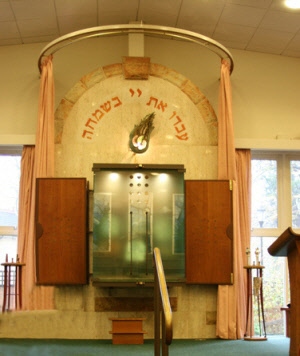ICJudaism: A Teacher’s Guide to Judaism
Hosted by ICTeachers Formerly: Mike’s Rough Guide to Judaism
Disclaimer:
The contents of these pages represent the author’s personal views, experience and
understanding.
There are bound to be some things here that some Jews would disagree
with.
Synagogue 2
There is no set design for a synagogue, rather there are four things that need to be present in the room that is used for prayer:
1 & 2. At least one Sefer Torah (Torah scroll) which will be stored in a cupboard
called the Ark (in Hebrew the ark is called the Aron HaKodesh (Holy cupboard) . It
may be built in to a wall, mounted on the wall or free-
The ark often has curtains that are drawn when there is no service going on, or even during parts of a service when the ark is closed.
3. Above the Ark is the Ner Tamid (perpetual light), the reminder of God’s presence.
The Ner Tamid is kept burning (or, these days, switched on) continuously. It is a
reminder of the Menorah (the 7-
4. The bimah is a raised platform from where the Torah scrolls are read. The bimah
may be in the centre of the room or it may be right in front of the Ark, as in the
photograph above -
Seating
In an orthodox synagogue there will separate sections for men and women. Generally the women’s section is separated from the men’s by a curtain or is upstairs in a “ladies gallery”. In a progressive synagogue there is more likely to be mixed seating.
Seating may be fixed -
Decoration
In line with the 2nd of the 10 Commandments (Judaism usually refers to them as the 10 Sayings), synagogues are unlikely to contain likenesses of people or animals (such as statues, paintings or stained glass representations of biblical stories or characters etc.). While many synagogues do have stained glass, its designs are generally abstract. There may be sculptured or carved objects, or abstract images (often donated in memory of deceased relatives). Many synagogues are plainly decorated.
 A modern Aron HaKodesh (ark). The wooden panels are actually doors which can be closed
when there is no service in progress.
A modern Aron HaKodesh (ark). The wooden panels are actually doors which can be closed
when there is no service in progress.
Note the Ner Tamid, just above the ark and, above that, the community’s chosen slogan: which means Serve the Lord with Joy, a quote from Psalm 100. You can tell from the handrail that there are steps leading up to the Ark.
4Wimbledon & District Synagogue, London)
